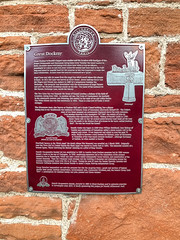Great Dockray
Great Dockray
man
Aged unknown
Commemorated on 1 plaque
Great Dockray Great Dockray is Penrith's largest open market and the location with Sandgate of the former Whitsunside and Martinmas hiring fairs, every Tuesday the market is held. In earlier times bull-bating was held here when it was an offence, punishable by a fine, to sell bull meat unless it had been tied to the bull ring and baited by mastiffs bred for the purpose as this was supposed to make the meat wholesome. In later years the practice continued as a ‘sport'. Angel lane may take is name from the Angel inn which stood where this plaque is fixed. In 1811, the Lane was known as Silver Street. About half way down was the Wagon and Horses Inn, replace in 1880 by a temperance hostelry, the Exchange. This property was demolished with the development of Angel Square and now the Bluebell Bookshop stands on the site. The name of the entrance to the Square, Exchange Lane, recalls the history. The Two Lions Pan was formerly the home of Gerard Lowther, a forbear of the Earls of Lonsdale, dating from 1585. In another old inn, The Duke of Cumberland, the landlady in the nineteenth century, Ann Pickering, also carried on the trade of tea and coffee dealer. The White House Inn was first mentioned in 1834. There is a fine row of Grade II listed cottages. The Gloucester Arms, also known as Dockray Hall and a Grade I listed building, has a plaque stating that it was traditionally the residence of Richard, Duke of Gloucester, afterwards Richard III. The Dukes arms of two boars rampant are prominently displayed above the main entrance. Over another doorway is the inscription ‘IW1580', the initials of John de Whelpdale who remodelled the house. Writing of Penrith Castle in 1787 James Clarke tells us that an arched subterraneous road leads all the way from the castle to the kitchen door of a house in the town, called Dockray Hall. No one has found the tunnel! Penrith Castle was begun in 1399 when William Strickland, later Bishop of Carlisle and Archbishop of Canterbury, added a stone curtain wall to the original pele tower. It was improved and added to over the next 70 years, finally to become a royal fortress for Richard, Duke of Gloucester, as 'Guardian of the west march towards Scotland’. Although Governor of Carlisle, he often resided in Penrtih. Familiarly known as the Black Angel the South African War Memorial was unveiled on 1 March 1906, Originally near the Town Hail in Corney Square the Black Angel was moved to Castle Park in 1964. The memorial consists of a bronze figure, ‘Peace Crowning the Heroes' standing on a pillar of Shap Granite. Penrith Co-operative Society Ltd was established in 1890 in humble Great Dockray premises but by 1893 success forced a move to the top of Castlegate. In 1903, continuing expansion led to the acquisition of the present extensive site at Barowgate, which had seen a much earlier unsuccessful Co-op venture, and construction of the Central Premises. Time has witnessed many changes and the building of character and distinction houses the modem Departmental Store with lifts to all floors. During the past 30 years the former Keswick, Lazonby and Naworth Collieries Societies have joined Penrith to create a larger, thriving independent Go-op Coop founders bequeathed not only the property but also the ongoing vision - goods and services of highest quality, keen prices, heritage preservation, environmental care, Community Dividend, and, the famous Co-op Cash ‘Divi’ - a prescription for member loyalty, and past, present and future success! Penrith Co-operative Society, founded in 1890, in Great Deckray and in extensive premises in Barrowgate since 1910, is kindly sponsoring this plaque for Penrith Millennium Trail
Great Dockray, Penrith, United Kingdom where it was

